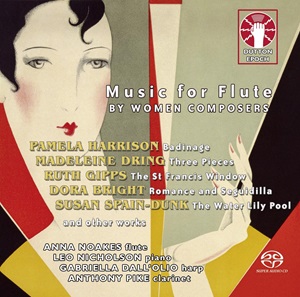
Music for Flute by Women Composers
Anna Noakes (flute and alto flute); Leo Nicholson (piano); Anthony Pike (clarinet); Gabriella Dall’Olio (harp)
rec. 2021, St George’s Headstone, Harrow, UK
Dutton Epoch CDLX7409 [71]
For British music collectors, the good news here is that the only pieces to have been previously recorded are Elizabeth Poston’s Trio and Grace Williams’ Sonatina. All-women discs, however, make me rather uneasy as they smack too much of the ghetto. That said, a reviewer can only review what’s in front of him and the apparent popularity of all-women discs shows no sign of diminishing.
The two most impressive works are those that have already been recorded. Elizabth Poston’s Trio for flute, clarinet and harp was composed in 1958. It is a four-movement work, spectral, dreamlike – the notes are right about this quality – but ballad-like in the second movement with antique hues, especially in the harp writing. Deliciously diaphanous in the ‘Dolce delicato’ third movement, there is a comic, witty feel to the finale with its birdlike squawks, its avian tapestry of rippling harp arpeggios. Composed in 1931, Grace Williams’ Sonatina for flute and piano is cast on a similarly compressed scale in three movements. Here one finds neoclassical elements in writing of vivacity and colour. The central slow movement is an example of Williams’ command of calm, expressive cool and the finale, which is dextrous and virtuosic, also contains a few avian evocations, though not in the profusion that one finds in the Poston.
The remainder of the pieces are new to disc. Susan Spain-Dunk’s The Water Lily Pool was originally composed for flute, harp and strings for performance by the British Women’s Symphony Orchestra. It offers a languid, scenic picture with athletic flurries, and some romantic piano writing. The flute writing is rather impressionistic. There’s cheery Edwardiana in the Petite Serenade and a tuneful salon-styled Valse Caprice. Dora Bright is represented by her Romance and Seguidilla for flute and piano, a piece of decorous Victoriana, and Pamela Harrison, the least-well known of the seven composers, by her Badinage – bright, sparkling and very brief.
Ruth Gipps has more representation, her three pieces spanning the years 1939 to 1986 – so very early and late Gipps. The most interesting is The St Francis Window, composed in 1986, notable for its warm sense of colour and the use of the alto flute. Gipps’ piano chording is expressively rich and seems to chime or move in romantic-mystic directions; highly effective. Her teenage self in the other two pieces offers the carefree and the wistful.
I’ve always liked Madeleine Dring’s music. I just like the cut of her jib. Her Polka is delightful, and the Three Pieces offer freshness and gentle pleasures alike. Her Tango, in particular, is both charming and full of insouciant colour, but the gentle, reflective Sarabande runs it close.
The performances are excellent with Anna Noakes taking on much of the burden with pianist Leo Nicholson, but clarinettist Anthony Pike and harpist Gabriella Dall’Olio prove just as able. The recording has been well judged in a favourite Dutton venue. Sophie Fuller writes the typically accomplished notes.
Jonathan Woolf
Buying this recording via a link below generates revenue for MWI and helps us keep free access to the site


Track listing
Susan Spain-Dunk (1880-1962)
The Water Lily Pool (1925)
Petite Serenade (1907)
Valse Caprice (1909)
Elizabeth Poston (1905-1987)
Trio for Flute, Clarinet and Harp (1958)
Dora Bright (1862-1951)
Romance and Seguidilla (1891)
Pamela Harrison (1915-1990)
Badinage (1963)
Grace Williams (1906-1977)
Flute Sonatina (1931)
Ruth Gipps (1921-1999)
The St Francis Window, Op 67 (1986)
Pixie Caravan, Op 3a (1939)
Rowan, Op 12a (1940)
Madeleine Dring (1923-1977)
Polka (1962)
Three Pieces (publ. 1983)

















